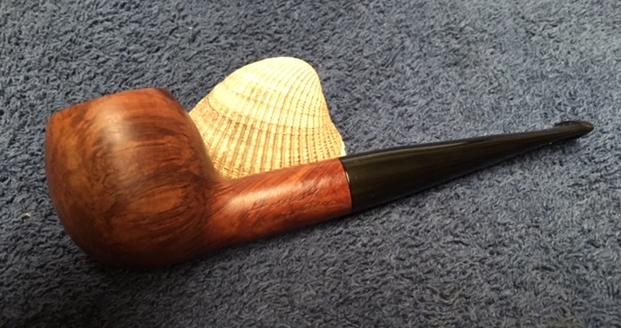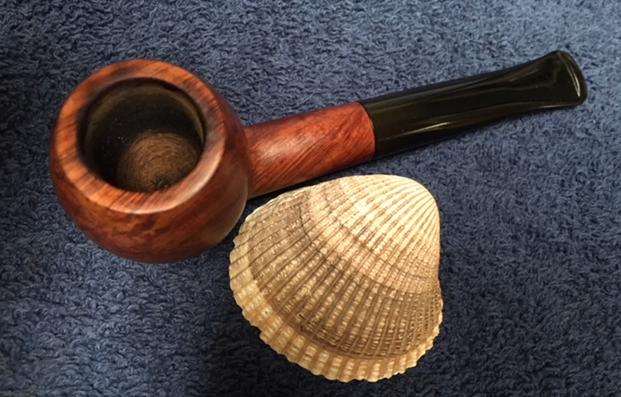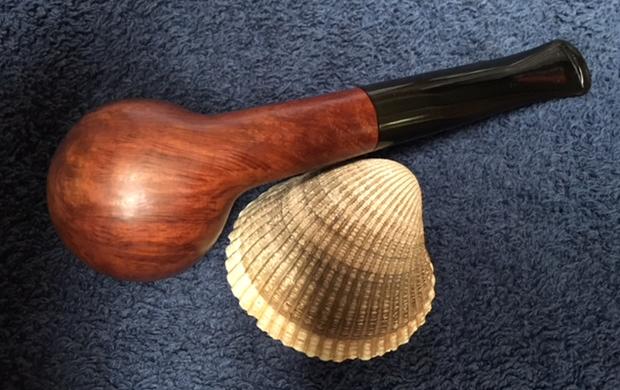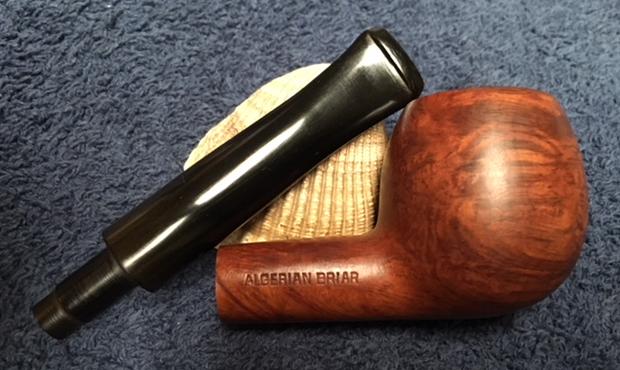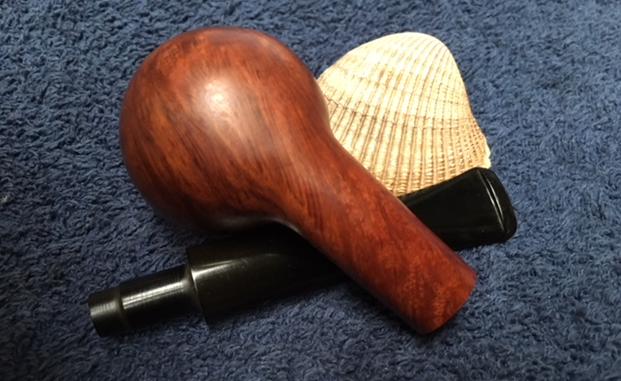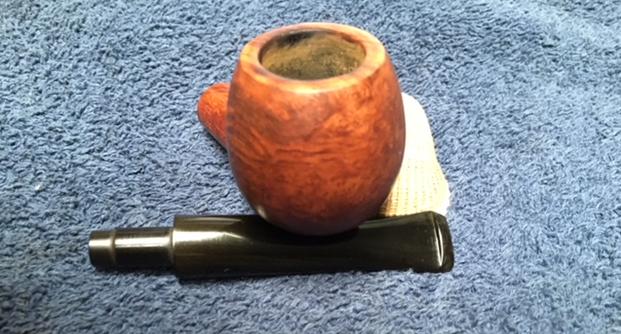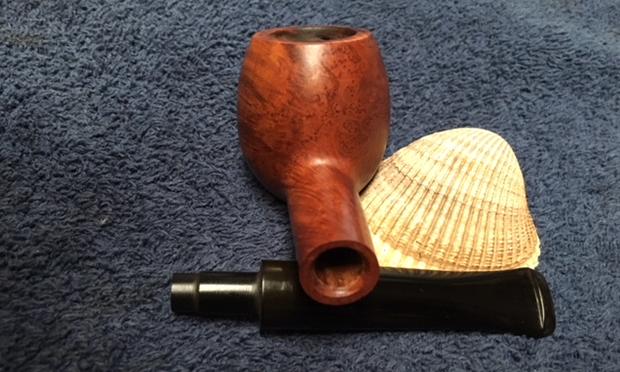Blog by Steve Laug
I am working on the last of the House of Robertson pipes that Jeff picked up on his weekly pipe hunts. He found several others that are quite unique in an antique mall near where he lives. There were two large long shanked pipes – one round shanked and one square shanked. The third of the batch that he found is a nice little classic apple shape. It looks tiny with the size of the other two. The two larger pipes are a combination of smooth and rusticated. They both have smooth panels on the sides or front of the pipes. Both of the large ones are banded with a sterling silver band. It seems to me that the bands on both the square shank and the round shank are decorative rather than a repair for a cracked shank.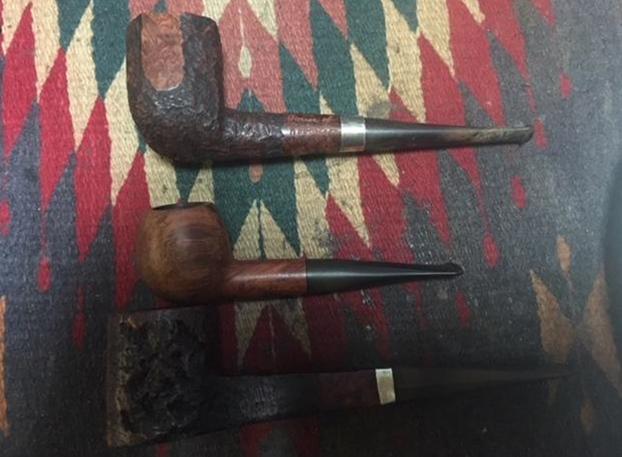
 I have restored the larger rusticated pipes already and they have traveled to two House of Robertson collectors – on in Idaho and one in Utah. I am finally getting to the third – the small apple. Like the other two, in fact like all of them the name House of Robertson roughly hand-etched on the side of the shank with an engraving tool. I am including the information that I found when I received my first of the House of Robertson Pipes. I found a link on Pipedia that gave me the only information I could find on the brand. I include that in total as it is interesting to read.
I have restored the larger rusticated pipes already and they have traveled to two House of Robertson collectors – on in Idaho and one in Utah. I am finally getting to the third – the small apple. Like the other two, in fact like all of them the name House of Robertson roughly hand-etched on the side of the shank with an engraving tool. I am including the information that I found when I received my first of the House of Robertson Pipes. I found a link on Pipedia that gave me the only information I could find on the brand. I include that in total as it is interesting to read.
“House of Robertson” was in business for many years, but alas, closed their doors in 1999. They were located in Boise, Idaho. They are noted for making rather large and interesting pipes. Thayne Robertson was a Master Mason, AF & AM, and started the shop about 1947 and his son Jon started working there in 1970 when he finished college, along with Thayne’s daughter. Thayne and his son started making the big pipes at that time, and made them together until 1987 when Thayne passed away. Jon kept the store and his sister moved on to other things. The House of Robertson appears to have closed around 1999. https://pipedia.org/wiki/Robertson
While this pipe looks tiny in the photos above it is really an average sized pipe. The curve of the apple shaped bowl leaves the bottom almost flat and the pipe sits nicely on the desk top like a sitter. It is completely different from the two larger pipes in that it is completely smooth with no rustication. The bowl has some interesting grain on it – almost circles on each side and some flame grain. The bowl is caked with some lava overflow on the rim top. The outer and inner edges of the rim look to be in good condition. It is engraved with the House of Robertson signature on the left side of the shank and on the right side it is stamped Algerian Briar. The pipe was dirty but underneath all of the grime it appears to be in excellent condition. It is definitely an interesting pipe and should clean up very well. The fit of the stem to the shank was good. The stem was lightly oxidized and had some small tooth marks and chatter on both sides near the button. Jeff took photos of the pipe before he started the cleanup. 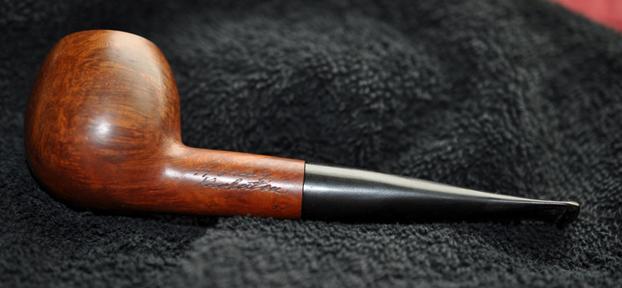
 The next two close-up photos show the finish on the top of the bowl and the underside of the bowl. The first photo shows the cake in the bowl and the lava overflowing onto the rim top. The grain on the top of the bowl and the inner and outer edge of the rim looks really good. The finish on the rim top appeared to be in great condition under the lava coat. The second photo shows the front and underside of the pipe. The finish is decent condition under the grime.
The next two close-up photos show the finish on the top of the bowl and the underside of the bowl. The first photo shows the cake in the bowl and the lava overflowing onto the rim top. The grain on the top of the bowl and the inner and outer edge of the rim looks really good. The finish on the rim top appeared to be in great condition under the lava coat. The second photo shows the front and underside of the pipe. The finish is decent condition under the grime. The next photo shows the etched name on the left side of shank on the shank. It reads House of Robertson. On the right side it is stamped Algerian Briar.
The next photo shows the etched name on the left side of shank on the shank. It reads House of Robertson. On the right side it is stamped Algerian Briar.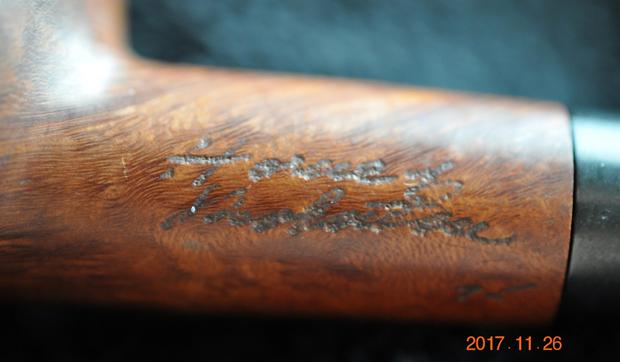 The tapered stem was lightly stamped France on the underside near the stem/shank union. It was oxidized and had tooth chatter and marks on both sides of the stem near the button. The edge of the button had some dents in it as well.
The tapered stem was lightly stamped France on the underside near the stem/shank union. It was oxidized and had tooth chatter and marks on both sides of the stem near the button. The edge of the button had some dents in it as well.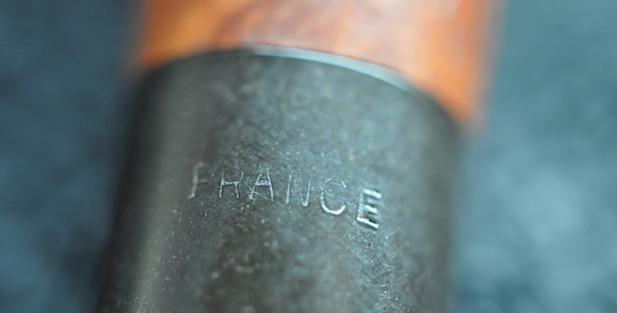
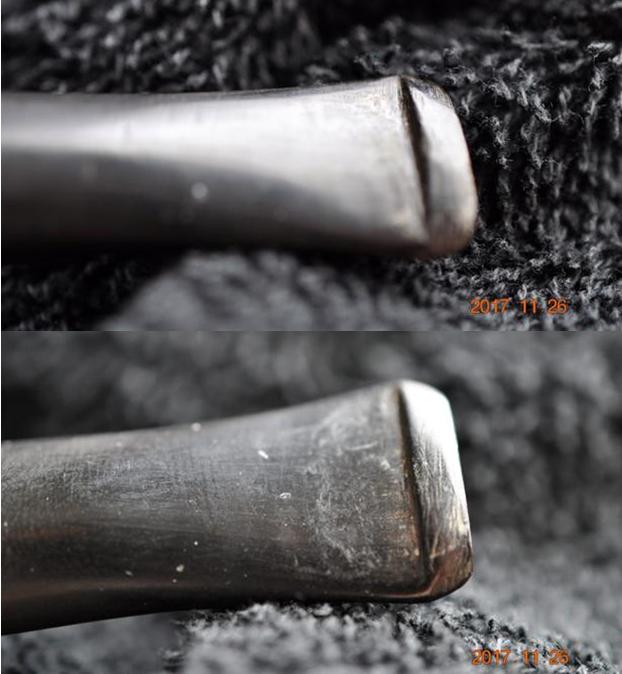 Jeff did a great job cleaning the pipe on the inside and outside. He reamed the bowl with a PipNet pipe reamer and cleaned up the remnants with the Savinelli Fitsall Pipe Knife. He scrubbed out the mortise and the airway in the shank and stem with alcohol, cotton swabs and pipe cleaners. He scrubbed the exterior of the bowl with a tooth brush and Murphy’s Oil Soap to remove the dust in the rustication on the bowl and shank as well as the smooth portions. He rinsed it under running water. He dried it off with a soft cloth. Once the dust and debris were removed the finish was dull but appeared to be in excellent condition. He soaked the stem in Before & After Pipe Stem Deoxidizer and rinsed it under warm water to remove the deoxidizer gel solution. I took photos of the pipe to show its condition before I started my work on it.
Jeff did a great job cleaning the pipe on the inside and outside. He reamed the bowl with a PipNet pipe reamer and cleaned up the remnants with the Savinelli Fitsall Pipe Knife. He scrubbed out the mortise and the airway in the shank and stem with alcohol, cotton swabs and pipe cleaners. He scrubbed the exterior of the bowl with a tooth brush and Murphy’s Oil Soap to remove the dust in the rustication on the bowl and shank as well as the smooth portions. He rinsed it under running water. He dried it off with a soft cloth. Once the dust and debris were removed the finish was dull but appeared to be in excellent condition. He soaked the stem in Before & After Pipe Stem Deoxidizer and rinsed it under warm water to remove the deoxidizer gel solution. I took photos of the pipe to show its condition before I started my work on it.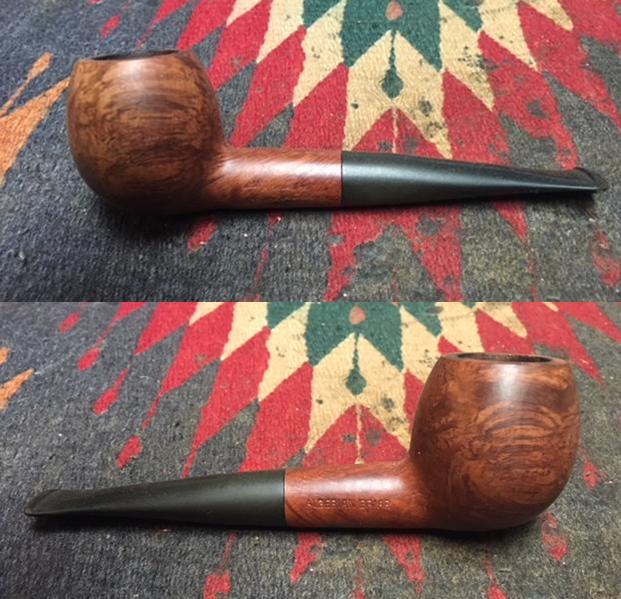
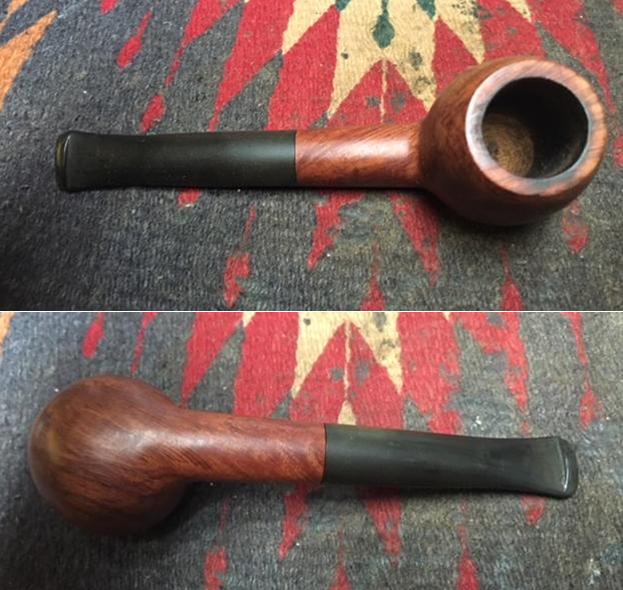 I took a photo of the bowl and rim top to show how well it had cleaned up. There is some rim darkening but you can see the interesting grain on the top of the bowl. The stem looks lightly oxidized and the tooth marks and chatter are very light.
I took a photo of the bowl and rim top to show how well it had cleaned up. There is some rim darkening but you can see the interesting grain on the top of the bowl. The stem looks lightly oxidized and the tooth marks and chatter are very light. I worked on the darkening of the inner edge of the rim with a folded piece of 220 grit sandpaper. I smoothed out the inner edge as can be seen in the second photo.
I worked on the darkening of the inner edge of the rim with a folded piece of 220 grit sandpaper. I smoothed out the inner edge as can be seen in the second photo. I polished the rim top with micromesh sanding pads – wet sanding with 1500-2400 grit pads and dry sanding with 3200-12000 grit pads. I wiped the rim top off with a damp cotton pad after each sanding pad. The surface began to take on a nice shine.
I polished the rim top with micromesh sanding pads – wet sanding with 1500-2400 grit pads and dry sanding with 3200-12000 grit pads. I wiped the rim top off with a damp cotton pad after each sanding pad. The surface began to take on a nice shine.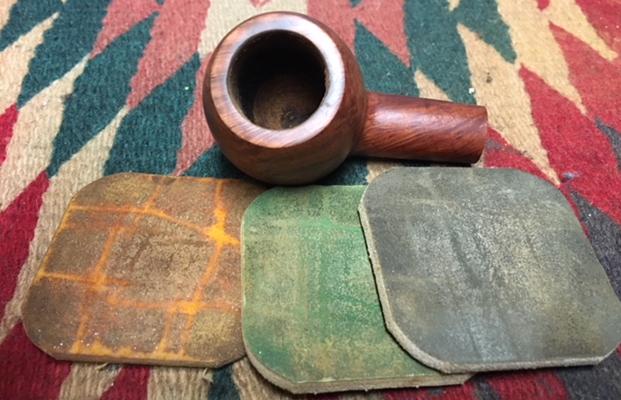

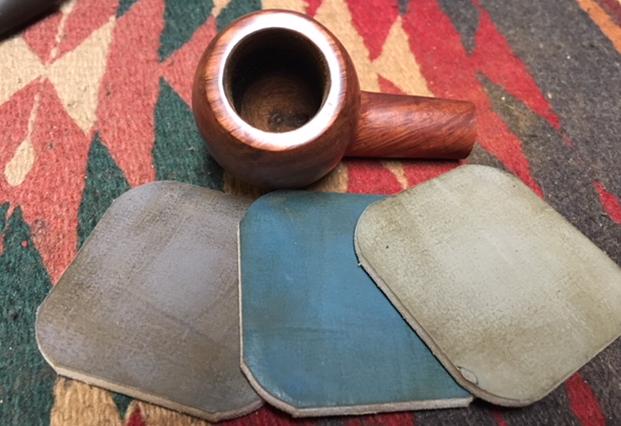 I worked Before & After Restoration Balm deep into the smooth finish to clean, enliven and protect the briar. I hand rubbed it with my fingers and worked it into the finish then set it aside to dry for a little while. I wiped it off with a soft cloth. I buffed the bowl with a cotton cloth to polish it. It really began to have a deep shine in the briar. I took some photos of the bowl at this point to mark the progress in the restoration. The grain on the bowl stands out with interesting lines moving across the sides of the bowl and the shank.
I worked Before & After Restoration Balm deep into the smooth finish to clean, enliven and protect the briar. I hand rubbed it with my fingers and worked it into the finish then set it aside to dry for a little while. I wiped it off with a soft cloth. I buffed the bowl with a cotton cloth to polish it. It really began to have a deep shine in the briar. I took some photos of the bowl at this point to mark the progress in the restoration. The grain on the bowl stands out with interesting lines moving across the sides of the bowl and the shank.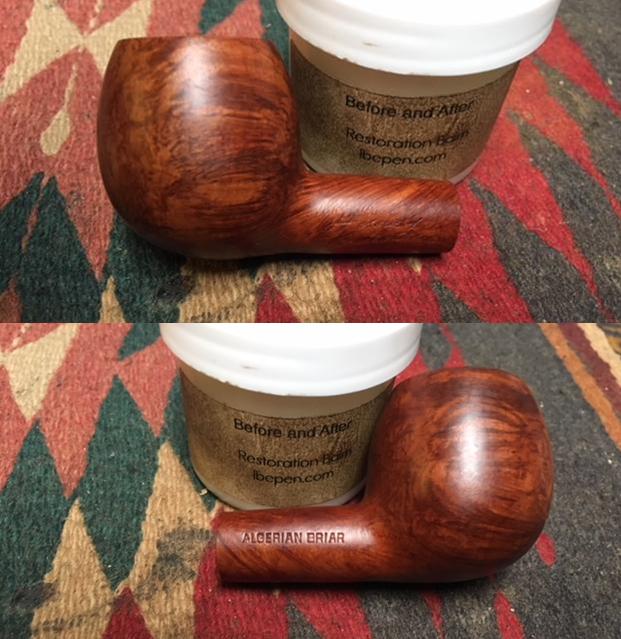
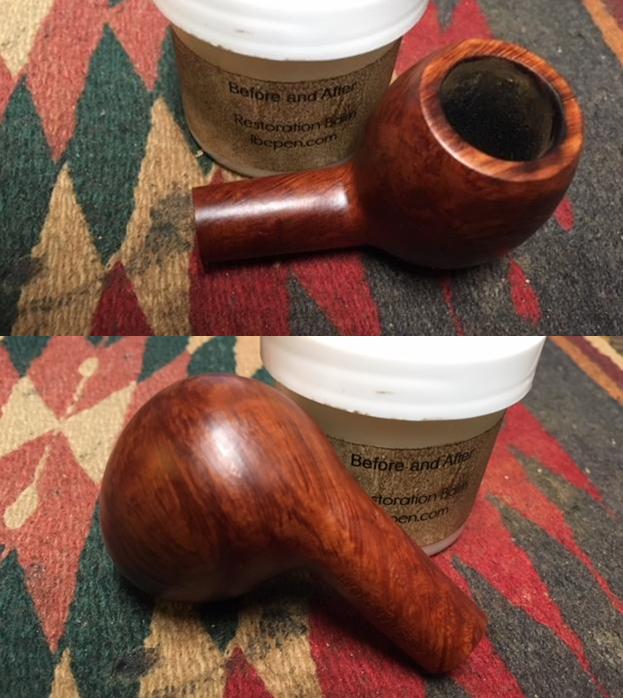 I looked over the stem a bit before working on it. There was an odd inner tube contraption that stuck out from a deeply funneled tenon. The tube was crooked and slightly bend. I examined it and found that it had a crack in the bottom of the aluminum so a slight movement and it fell off in my hand. I cleaned out the funneled area with cotton swabs and alcohol and ran pipe cleaners and alcohol through the stem quite easily now that the end of the tube was gone.
I looked over the stem a bit before working on it. There was an odd inner tube contraption that stuck out from a deeply funneled tenon. The tube was crooked and slightly bend. I examined it and found that it had a crack in the bottom of the aluminum so a slight movement and it fell off in my hand. I cleaned out the funneled area with cotton swabs and alcohol and ran pipe cleaners and alcohol through the stem quite easily now that the end of the tube was gone.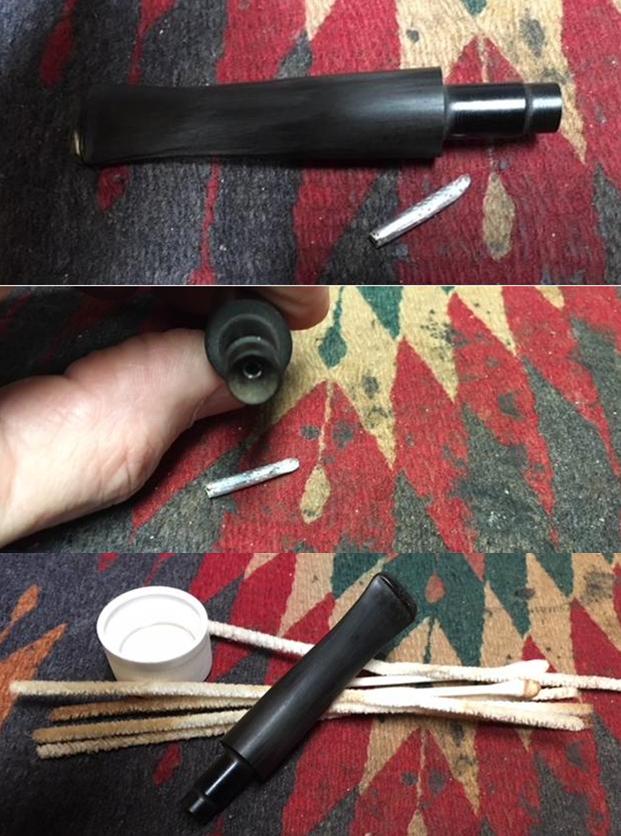 I sanded the stem with 220 grit sandpaper to remove the oxidation on both sides of the tapered stem and remove the tooth marks and chatter on the top and bottom sides at the button.
I sanded the stem with 220 grit sandpaper to remove the oxidation on both sides of the tapered stem and remove the tooth marks and chatter on the top and bottom sides at the button.  I polished out the sanding scratches and marks in the vulcanite with micromesh sanding pads – wet sanding it with 1500-2400 grit pads and dry sanding it with 3200-4000 grit pads. I wiped the stem down with Obsidian Oil after each sanding pad. I buffed the stem with Blue Diamond on the buffing wheel. I brought it back to the table and sanded it with the final three 6000-12000 grit pads. I polished it further with Before & After Pipe Polish – using both the Fine and Extra Fine Polishes. I gave it a rubdown with Obsidian Oil one last time and set it aside to dry.
I polished out the sanding scratches and marks in the vulcanite with micromesh sanding pads – wet sanding it with 1500-2400 grit pads and dry sanding it with 3200-4000 grit pads. I wiped the stem down with Obsidian Oil after each sanding pad. I buffed the stem with Blue Diamond on the buffing wheel. I brought it back to the table and sanded it with the final three 6000-12000 grit pads. I polished it further with Before & After Pipe Polish – using both the Fine and Extra Fine Polishes. I gave it a rubdown with Obsidian Oil one last time and set it aside to dry.
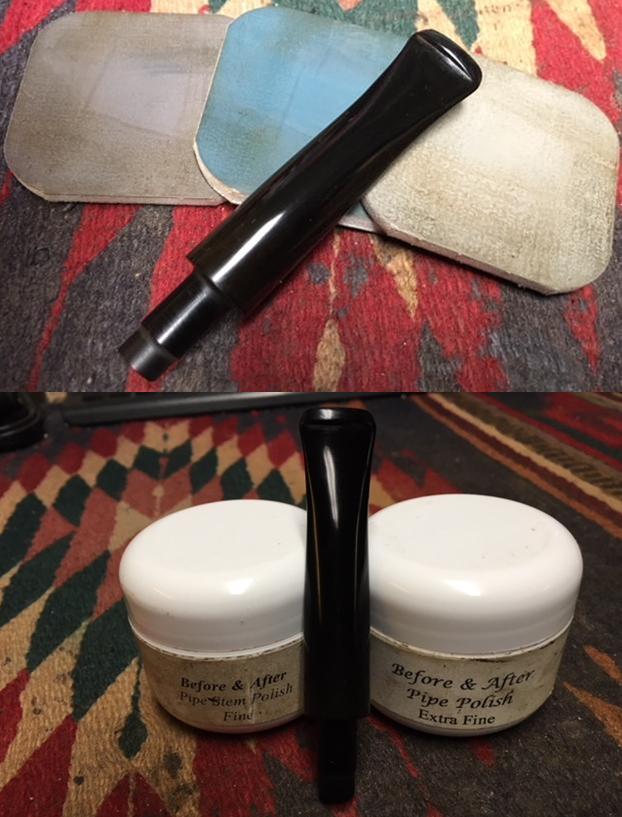 I put the stem back on the bowl and worked the pipe over on the buffing wheel using Blue Diamond to lightly polish the stem. I buffed the bowl and stem to raise the gloss on the briar and the vulcanite. I gave the pipe multiple coats of carnauba wax. I buffed the entire pipe with a clean buffing pad to raise the shine. I hand buffed it with a microfiber cloth to deepen the shine. The finished pipe is shown in the photos below. The medium brown stains on the smooth apple shaped bowl works well with the rich black of the vulcanite stem. The dimensions of the pipe are: Length: 5 1/4 inches, Height: 1 5/8 inches, Outside Diameter: 1 1/4 inches, Diameter of the chamber: 3/4 inches. This is an interesting piece of briar, cross grain and birdseye on the bowl and shank. The patterns on the sides are almost circular. I really like how the briar and the vulcanite work well together. This one will soon be on the rebornpipes store. If you are interested in adding a House of Robertson to your collection this may well be the one for you. Thanks for walking with me through the restoration process.
I put the stem back on the bowl and worked the pipe over on the buffing wheel using Blue Diamond to lightly polish the stem. I buffed the bowl and stem to raise the gloss on the briar and the vulcanite. I gave the pipe multiple coats of carnauba wax. I buffed the entire pipe with a clean buffing pad to raise the shine. I hand buffed it with a microfiber cloth to deepen the shine. The finished pipe is shown in the photos below. The medium brown stains on the smooth apple shaped bowl works well with the rich black of the vulcanite stem. The dimensions of the pipe are: Length: 5 1/4 inches, Height: 1 5/8 inches, Outside Diameter: 1 1/4 inches, Diameter of the chamber: 3/4 inches. This is an interesting piece of briar, cross grain and birdseye on the bowl and shank. The patterns on the sides are almost circular. I really like how the briar and the vulcanite work well together. This one will soon be on the rebornpipes store. If you are interested in adding a House of Robertson to your collection this may well be the one for you. Thanks for walking with me through the restoration process.